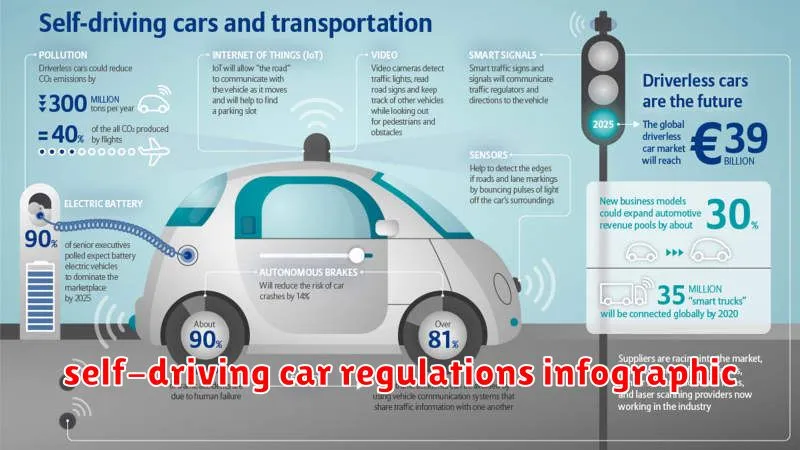The age of autonomous vehicles is upon us, promising a future of safer roads, reduced congestion, and increased mobility. However, this exciting new era comes with its fair share of challenges, particularly in navigating the complex web of regulations governing self-driving cars. From safety standards and liability to data privacy and infrastructure compatibility, the regulatory landscape for autonomous vehicles is rapidly evolving, posing both opportunities and obstacles for the industry.
This article delves into the intricate world of self-driving car regulations, unpacking the key considerations that shape this burgeoning field. We will explore the different regulatory approaches adopted by various countries, examine the crucial role of testing and validation, and shed light on the ongoing debate surrounding ethics and accountability in the context of autonomous driving. Join us as we unravel the complexities and navigate the road to a future where self-driving cars become a mainstream reality.
The Current Landscape of Self-Driving Car Regulations
The advent of self-driving cars, also known as autonomous vehicles (AVs), has sparked a global race to establish regulatory frameworks that ensure safety, public trust, and seamless integration into existing transportation systems. This landscape is dynamic, with different jurisdictions adopting diverse approaches, making it crucial to understand the key elements shaping the future of AV regulations.
Testing and Deployment: Regulations governing testing and deployment of AVs vary significantly. Some jurisdictions, such as California, have established comprehensive frameworks for testing and data collection, while others, like Arizona, have adopted a more permissive approach, allowing for faster deployment.
Liability and Insurance: One of the most complex aspects of AV regulation is determining liability in the event of an accident. Current laws often focus on the driver’s actions, presenting challenges for assigning responsibility when a vehicle is operating autonomously. Establishing clear liability frameworks is crucial for building public trust and ensuring fair compensation for victims.
Data Privacy and Security: AVs generate vast amounts of data, raising concerns about privacy and security. Regulations are emerging to address these concerns, requiring manufacturers to implement measures protecting user data and ensuring the integrity of vehicle systems.
Safety Standards: Setting safety standards for AVs is paramount. Governments and regulatory bodies are developing rigorous standards to evaluate vehicle performance, including aspects like braking, steering, and obstacle detection. These standards aim to ensure that AVs meet the highest safety requirements.
Ethical Considerations: The introduction of AVs raises ethical dilemmas, such as the allocation of resources in the event of an unavoidable accident. Regulatory frameworks are being developed to address these ethical challenges, promoting transparency and accountability in decision-making algorithms.
As AV technology continues to advance, the regulatory landscape will evolve. Ongoing collaboration between governments, industry stakeholders, and researchers is essential for creating a harmonized and effective regulatory environment that fosters innovation while prioritizing safety and societal well-being.
Federal vs. State Regulations: A Patchwork Approach
The development of self-driving cars presents a unique challenge: balancing innovation with safety. As these vehicles navigate the road to autonomy, a complex web of regulations is emerging, creating a patchwork of rules across different jurisdictions. While the federal government establishes broad guidelines, individual states are also enacting their own laws, leading to a fragmented regulatory landscape.
The National Highway Traffic Safety Administration (NHTSA), the federal agency responsible for vehicle safety, is actively developing regulations for autonomous vehicles. The agency has issued guidelines for testing and deploying these vehicles, focusing on safety standards, data recording, and driver oversight. However, the federal approach remains largely aspirational, leaving significant room for states to define their own specific rules.
States like California, Nevada, and Arizona have taken a proactive stance, enacting regulations that cover everything from testing requirements to liability issues. These regulations often go beyond federal guidelines, requiring additional safety measures, data sharing, and even the presence of a human driver for specific scenarios. This divergence creates challenges for companies developing autonomous vehicle technology, as they must comply with a patchwork of regulations across different states.
The patchwork approach can lead to regulatory uncertainty, making it difficult for companies to scale their operations nationally. For example, a vehicle that meets California’s regulations may not be compliant in Texas, leading to costly modifications or delays in deployment. This lack of uniformity also raises concerns about legal liability in the event of an accident. Determining fault and applying appropriate laws can become convoluted when multiple jurisdictions are involved.
Moving forward, finding a balance between federal guidance and state autonomy is crucial. A more unified regulatory framework would foster innovation and ensure consistent safety standards for self-driving vehicles. While allowing states to address specific local concerns, clear national guidelines are essential for creating a more predictable and efficient regulatory environment for this rapidly evolving technology.
Safety Standards and Testing Requirements for Autonomous Vehicles
As autonomous vehicles (AVs) inch closer to mainstream adoption, the question of safety takes center stage. Regulators worldwide are grappling with the challenge of establishing robust safety standards and testing requirements for these innovative vehicles. This blog post delves into the crucial aspects of ensuring the safety and reliability of AVs on our roads.
Safety Standards are a critical cornerstone of AV regulations. They define the performance metrics and criteria that AVs must meet to operate safely. These standards cover a wide range of aspects, including:
- Perception and Sensor Capabilities: AVs must be able to accurately perceive their surroundings, including objects, pedestrians, and other vehicles.
- Decision-Making and Planning: The algorithms that govern an AV’s decision-making process must be reliable and robust, ensuring safe navigation and responses to unforeseen situations.
- Control and Actuation: The system responsible for steering, acceleration, and braking must be highly responsive and precise.
- Cybersecurity: AVs must be protected from cyberattacks that could compromise their safety or functionality.
Testing Requirements are equally vital in ensuring the safety of AVs. These requirements mandate rigorous testing to validate the vehicle’s performance and functionality under various real-world conditions. Key areas of focus include:
- Simulation Testing: AVs undergo extensive simulations to evaluate their performance in a wide range of scenarios, including different weather conditions, traffic densities, and road types.
- Closed-Course Testing: Testing in controlled environments allows engineers to assess the vehicle’s capabilities under specific conditions, such as lane changes, intersections, and emergency braking.
- Public Road Testing: Real-world testing on public roads is crucial to gather data and assess how the AV interacts with human drivers and pedestrians.
The development of comprehensive and rigorous safety standards and testing requirements is crucial for ensuring the safe deployment of autonomous vehicles. As the technology continues to evolve, ongoing research and collaboration between policymakers, manufacturers, and researchers are necessary to establish a framework that promotes innovation while safeguarding public safety.
Liability and Insurance Considerations for Self-Driving Cars
As self-driving cars inch closer to becoming commonplace, the question of liability and insurance arises. Who is responsible when an accident occurs involving a self-driving vehicle? Is it the manufacturer, the software developer, the car owner, or the passenger? Existing laws and insurance models are grappling to keep pace with this rapidly evolving technology.
In traditional cars, liability typically falls on the driver. However, in autonomous vehicles, the driver is essentially a passenger, relinquishing control to the vehicle’s AI. This raises complex questions about fault and responsibility. Will manufacturers be held liable for design flaws or software glitches? What about data security vulnerabilities that could lead to accidents? The traditional insurance system, built around individual drivers, might need a complete overhaul to address these new realities.
Some experts advocate for a “no-fault” insurance system, where the focus shifts from assigning blame to compensating victims. This could involve a system of pooled insurance, where all autonomous vehicle owners contribute to a fund that covers accidents regardless of fault. Alternatively, liability could be shared between manufacturers, software developers, and vehicle owners.
Furthermore, the data generated by autonomous vehicles presents a new challenge. Data on driving behavior, accidents, and system performance could be used to assess liability and adjust insurance premiums. However, privacy concerns arise regarding access to this data. Stricter regulations are needed to ensure responsible data collection and use.
Navigating the legal and insurance landscape for self-driving cars requires careful consideration of various factors. Clearer definitions of liability, standardized safety protocols, and innovative insurance models are essential to ensure a safe and responsible transition to autonomous vehicles.
Data Privacy and Cybersecurity in Autonomous Vehicles
As the development of autonomous vehicles (AVs) rapidly advances, the paramount importance of data privacy and cybersecurity becomes increasingly evident. AVs generate a vast amount of data, encompassing sensor readings, driver behavior, location information, and communication with other vehicles. This data is vital for navigation, decision-making, and overall vehicle operation, but also presents significant vulnerabilities if not properly secured.
One of the primary concerns is the protection of sensitive personal information. AVs collect data on passengers, including their identities, destinations, and driving habits. This information could be misused or compromised, leading to identity theft, tracking, and other privacy violations.
Cybersecurity threats pose another critical risk. AVs are interconnected systems susceptible to hacking, potentially allowing attackers to take control of vehicle functions, manipulate data, or cause harm. Malicious actors could disrupt traffic flow, compromise braking systems, or even access sensitive data stored within the vehicle.
Addressing these concerns necessitates a multi-faceted approach. Robust encryption and access control mechanisms are crucial to safeguarding sensitive data. Regular software updates and security patches are essential to mitigate vulnerabilities. Moreover, developing clear legal frameworks and ethical guidelines for data collection and usage is paramount to protect user privacy and rights.
Collaborative efforts among automakers, technology companies, policymakers, and cybersecurity experts are critical to ensure that AVs operate in a secure and responsible manner. This includes establishing industry standards, fostering research and development in cybersecurity, and raising public awareness about these critical issues.
Public Perception and Acceptance of Self-Driving Cars
The transition to a future with self-driving cars is not just about technological advancement; it’s also about navigating the complex terrain of public perception and acceptance. For self-driving vehicles to become a reality, public trust and confidence are paramount. This involves addressing a spectrum of concerns, from safety and security to ethical considerations and potential job displacement.
Safety and Security remain the top concerns for many. While proponents argue that self-driving cars have the potential to significantly reduce accidents caused by human error, skepticism persists. Public perception is heavily influenced by media reports of accidents involving autonomous vehicles, even if the number of incidents is relatively low compared to human-driven cars. Addressing these concerns requires transparent data collection and analysis, alongside rigorous testing and safety certifications.
Ethical dilemmas surrounding self-driving cars also contribute to public hesitancy. Questions about how these vehicles would make decisions in complex situations, especially in scenarios involving potential harm to passengers or pedestrians, are a subject of intense debate. The development of clear ethical guidelines and algorithms is crucial to building public trust.
Job displacement is another significant factor influencing public opinion. The rise of self-driving cars threatens the livelihood of millions employed in the transportation sector. Addressing this concern requires comprehensive strategies that encompass retraining, social safety nets, and exploring new job opportunities created by this emerging technology.
Ultimately, fostering public acceptance of self-driving cars requires a multifaceted approach. It involves fostering open dialogue, transparent communication, and addressing concerns with evidence-based solutions. As the technology continues to evolve, it’s crucial to engage with the public, involve them in the conversation, and build a shared understanding of the benefits and challenges associated with autonomous vehicles.
The Role of Infrastructure in Supporting Autonomous Driving
The transition to autonomous driving necessitates a comprehensive overhaul of our infrastructure to accommodate these advanced vehicles. While self-driving cars possess impressive capabilities, their performance hinges on a robust and supportive infrastructure. This includes:
Smart Traffic Signals: Traditional traffic lights are often ill-equipped to handle autonomous vehicles. Smart signals, capable of communicating with self-driving cars, can provide real-time traffic information, optimize traffic flow, and prevent potential conflicts.
High-Definition Mapping: Autonomous vehicles rely on precise, detailed maps to navigate. High-definition maps provide information beyond basic roads, including lane markings, road signs, traffic signals, and even obstacles. This detailed information enables autonomous vehicles to make informed decisions and navigate complex environments.
V2X (Vehicle-to-Everything) Communication: V2X technology empowers vehicles to communicate with each other, infrastructure, and pedestrians. This communication network enables autonomous vehicles to share information about their location, speed, and intended path, fostering safer and more efficient traffic flow.
Dedicated Lanes: Designating specific lanes for autonomous vehicles could improve traffic flow and reduce human error. These dedicated lanes could be equipped with sensors and communication infrastructure, creating a controlled environment optimized for autonomous vehicles.
Investing in these infrastructure advancements will be crucial for the successful integration of autonomous vehicles into our transportation system. A robust and intelligent infrastructure will not only enhance safety but also optimize traffic flow and unlock the full potential of self-driving technology.
International Harmonization of Self-Driving Car Regulations
The rapid advancement of self-driving car technology has sparked a global conversation about the regulations that govern their deployment. While the potential benefits of autonomous vehicles are vast, including increased safety and efficiency, achieving widespread adoption requires a harmonized regulatory landscape across borders. This is where international harmonization of self-driving car regulations becomes crucial.
The lack of uniform standards presents a significant challenge. Different countries have varying legal frameworks, ethical considerations, and technological capabilities. This patchwork of regulations can create barriers to the development, testing, and commercialization of autonomous vehicles. For instance, a car designed to comply with the laws of one country might not meet the requirements of another, leading to delays and costly modifications.
International harmonization aims to address these challenges by creating a common set of principles and guidelines that govern self-driving cars globally. This includes addressing critical aspects such as:
- Liability and insurance: Establishing clear rules for determining liability in case of accidents involving autonomous vehicles.
- Data privacy and security: Protecting the sensitive data collected by self-driving cars and ensuring its responsible use.
- Safety standards and testing: Setting rigorous safety standards for self-driving car technology and establishing standardized testing procedures.
- Cybersecurity: Ensuring that autonomous vehicles are resilient against cyberattacks and other security threats.
Harmonization efforts can take various forms, including:
- International cooperation: Governments and regulatory bodies working together to develop common standards and best practices.
- Multilateral agreements: Creating binding agreements between countries to harmonize their regulations.
- Industry-led initiatives: Collaboration between automotive manufacturers, technology companies, and research institutions to promote standardization.
By promoting international harmonization, we can create a more predictable and streamlined environment for the development and deployment of autonomous vehicles. This, in turn, will foster innovation, accelerate the adoption of this transformative technology, and ultimately contribute to a safer and more efficient transportation system for all.
The Future of Self-Driving Car Regulations: Trends and Predictions
The rapid development of autonomous vehicle technology is forcing regulators around the world to adapt and create new regulations. This shift raises many questions about the future of self-driving car regulations. What trends will shape this landscape? What predictions can we make about the direction these regulations will take?
One key trend is the move toward a performance-based approach. Traditional regulations focused on vehicle design and construction, but now, regulators are increasingly looking at how self-driving cars perform in real-world scenarios. This means evaluating their ability to navigate complex situations, react to unexpected events, and make safe decisions. This performance-based approach allows regulators to be more flexible and adapt to the rapidly evolving technology.
Another important trend is the increasing focus on data. Self-driving cars generate vast amounts of data, which can be used to understand their performance, identify potential safety issues, and even improve their algorithms. Regulators are working to develop guidelines for data collection, storage, and sharing to ensure safety and privacy. This data-driven approach is crucial for ensuring the safe deployment of autonomous vehicles.
Looking ahead, we can anticipate several predictions regarding self-driving car regulations:
- Increased harmonization: As more countries adopt regulations, there will be a push for greater harmonization of standards and guidelines. This will make it easier for self-driving car manufacturers to operate in multiple markets.
- Focus on cybersecurity: The increasing reliance on software and connectivity in self-driving cars makes cybersecurity a critical issue. Regulators will likely impose stricter regulations to protect against cyberattacks and ensure the safety and reliability of these vehicles.
- Integration with existing infrastructure: The development of regulations will need to consider how self-driving cars interact with existing infrastructure, such as traffic signals and road markings. This may require changes to existing infrastructure or the development of new systems specifically for autonomous vehicles.
The future of self-driving car regulations is still being written. By understanding these trends and predictions, we can better navigate the road to autonomy and ensure the safe and responsible deployment of this transformative technology.
Impact of Regulations on Innovation and Deployment of Self-Driving Cars
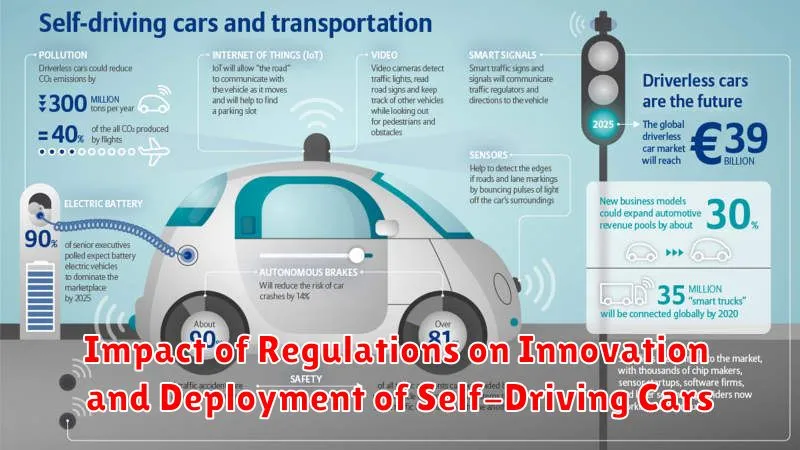
The rapid advancement of autonomous vehicle technology promises a future of safer, more efficient, and accessible transportation. However, the successful deployment of self-driving cars hinges on the careful navigation of a complex regulatory landscape. Regulations play a crucial role in shaping the pace of innovation and the adoption of self-driving cars, impacting both the development and deployment of this transformative technology.
On one hand, regulations can serve as a catalyst for innovation. Clear and concise regulatory frameworks can provide certainty for developers, encouraging investment and fostering a competitive market. Standardized testing procedures and safety guidelines can accelerate the development of robust autonomous systems. By setting clear expectations for safety and performance, regulations can help ensure consumer confidence and expedite the adoption of self-driving cars.
On the other hand, overly restrictive regulations can stifle innovation and hinder the deployment of self-driving cars. Complex or ambiguous regulations can create uncertainty for developers, discouraging investment and delaying progress. Furthermore, stringent regulations may limit the flexibility and adaptability of autonomous systems, hindering their ability to navigate real-world driving scenarios.
The optimal approach lies in striking a balance between promoting innovation and ensuring safety. Regulations should be flexible and adaptable to accommodate the evolving nature of autonomous technology while prioritizing public safety. Collaborative efforts between industry, government, and academia are crucial in developing and implementing regulations that foster a thriving ecosystem for self-driving car development and deployment.
Ethical Considerations in Autonomous Vehicle Regulations
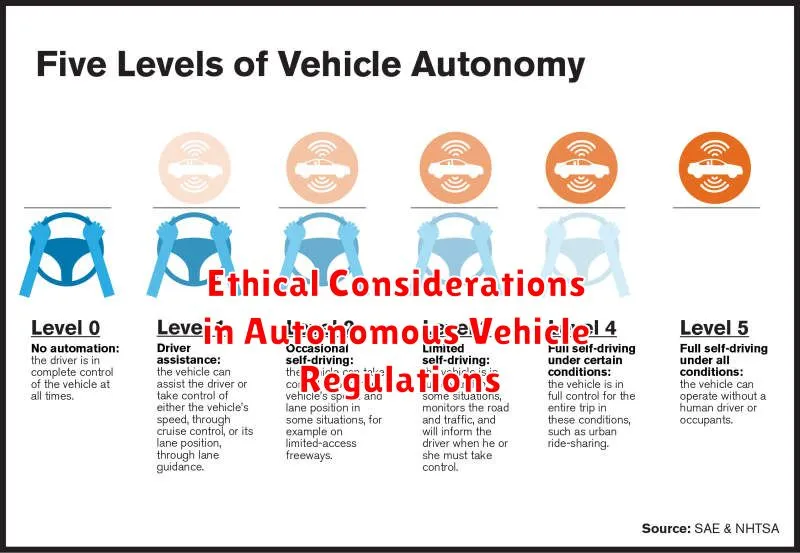
As autonomous vehicles (AVs) inch closer to becoming a mainstream reality, crafting robust regulations is crucial. While technical aspects like safety and performance are paramount, ethical considerations cannot be overlooked. These dilemmas, often referred to as the “moral machine problem,” pose significant challenges for policymakers and developers alike.
One of the most pressing ethical questions revolves around the allocation of risk in unavoidable accidents. In a collision scenario, who should an AV prioritize – the passengers, pedestrians, or other vehicles? This dilemma is complex as there’s no universally accepted framework for determining the “least harmful” outcome. Furthermore, the potential for algorithmic bias, where certain demographics might be unfairly disadvantaged by the AV’s decision-making, raises concerns about equity and fairness.
Another ethical concern lies in the transparency and accountability of AV decision-making. How will AVs justify their actions, especially in complex situations? Establishing clear protocols for data logging, incident investigation, and public disclosure is essential for building trust and ensuring accountability. The development of robust ethical frameworks, including moral algorithms and ethical guidelines for developers, is crucial to ensure AVs operate in a responsible and ethical manner.
Addressing these ethical challenges requires collaborative efforts from policymakers, industry leaders, and the public. Open dialogue and transparent communication are key to navigating this complex landscape and ensuring that the road to autonomy is paved with ethical considerations.
Challenges and Opportunities in Regulating Artificial Intelligence in Transportation
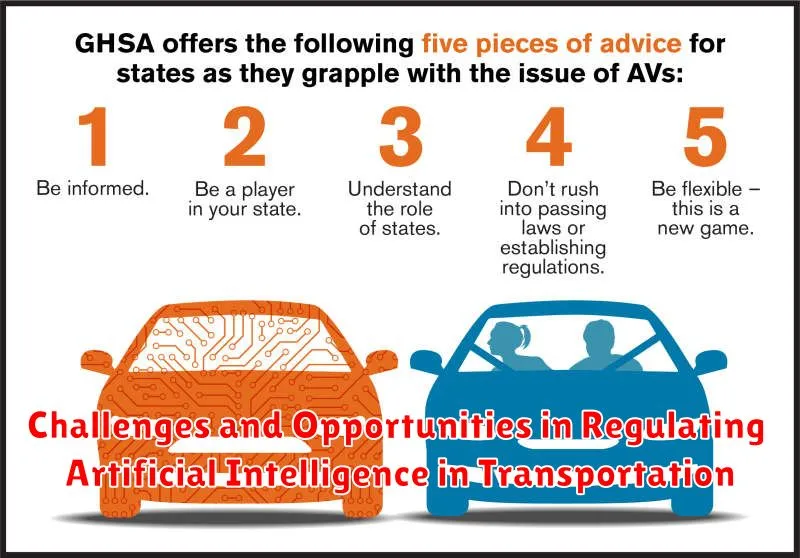
The rapid advancement of artificial intelligence (AI) has led to the emergence of self-driving cars, promising a future of increased safety, efficiency, and convenience in transportation. However, the integration of AI into the transportation sector presents significant challenges and opportunities that require careful consideration and regulation.
One of the main challenges is ensuring the safety and reliability of AI-powered vehicles. AI systems are trained on vast datasets and are prone to errors and biases. The potential for malfunctions or unexpected behavior in autonomous vehicles raises concerns about public safety. Regulators must establish stringent testing and certification processes to ensure that self-driving cars meet rigorous safety standards.
Another challenge lies in defining legal liability in the event of accidents involving autonomous vehicles. Who is responsible when an AI-controlled car causes an accident: the manufacturer, the driver, or the AI itself? Developing clear legal frameworks that address liability and accountability is crucial for establishing public trust in self-driving technologies.
Beyond safety, there are ethical considerations that must be addressed. AI systems are designed to make decisions based on algorithms, which can raise ethical questions about fairness, bias, and transparency. Regulators must ensure that AI systems used in transportation are developed and deployed ethically, with mechanisms in place to prevent discrimination and promote equitable access.
Despite the challenges, regulating AI in transportation presents significant opportunities for innovation and societal improvement. Self-driving cars have the potential to revolutionize transportation systems, reducing traffic congestion, improving fuel efficiency, and providing mobility options for individuals with disabilities. Regulators have the opportunity to foster a supportive environment that encourages responsible development and deployment of AI in transportation.
The road to autonomy requires careful navigation. Addressing the challenges and harnessing the opportunities presented by AI in transportation will require a collaborative effort between governments, industry stakeholders, and the public. By establishing comprehensive regulations and fostering ethical development, we can unlock the transformative potential of AI to create a safer, more efficient, and equitable future for transportation.
The Role of Public-Private Partnerships in Advancing Self-Driving Car Regulations
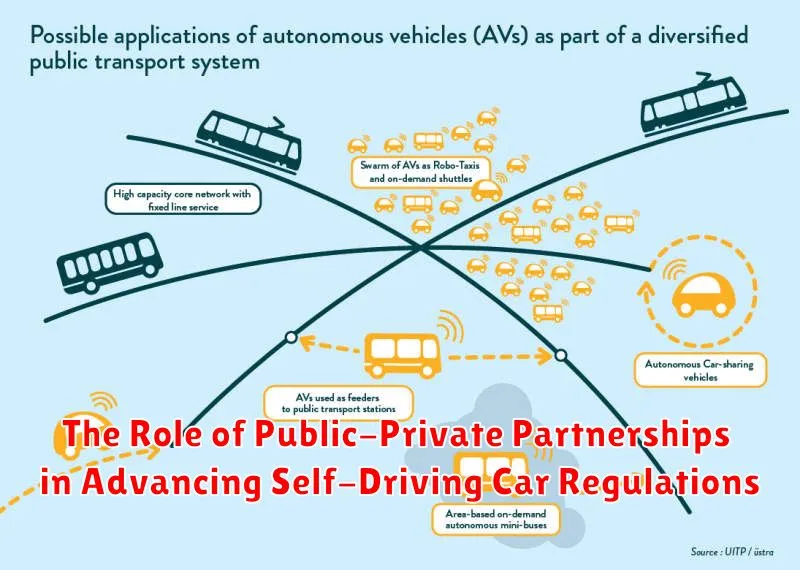
The development and deployment of self-driving cars, also known as autonomous vehicles (AVs), present a complex challenge that demands collaboration between the public and private sectors. Public-private partnerships (PPPs) play a crucial role in navigating the road to autonomy by fostering innovation, ensuring safety, and establishing clear regulatory frameworks.
Collaboration between government agencies, automotive manufacturers, technology companies, and research institutions is essential for addressing the multifaceted challenges surrounding AVs. PPPs can facilitate the sharing of knowledge, resources, and expertise to advance technological development, conduct rigorous testing, and refine regulatory standards. By working together, stakeholders can ensure that AVs meet safety and performance criteria while fostering a conducive environment for their deployment.
One significant area where PPPs are crucial is in the development of comprehensive safety guidelines. Public authorities are responsible for establishing regulations that ensure the safety of both passengers and pedestrians. However, the rapid evolution of AV technology necessitates ongoing collaboration with private sector companies to understand the latest advancements and incorporate them into regulations. PPPs enable real-time knowledge sharing, facilitating the development of adaptive and effective safety standards.
PPPs also play a critical role in establishing infrastructure and testing environments for AVs. Government agencies can leverage private sector resources to build designated testing areas, equip roads with necessary sensors and communication networks, and create controlled environments for simulating real-world scenarios. This infrastructure development not only accelerates the pace of AV development but also ensures that vehicles are rigorously tested and validated before being deployed on public roads.
The successful integration of AVs into existing transportation systems requires a collaborative approach that involves both the public and private sectors. Public-private partnerships are essential for bridging the gap between innovation and regulation, ensuring safety, and ultimately paving the way for a future where self-driving cars become an integral part of our daily lives.
Case Studies: Examining Different Regulatory Approaches Globally
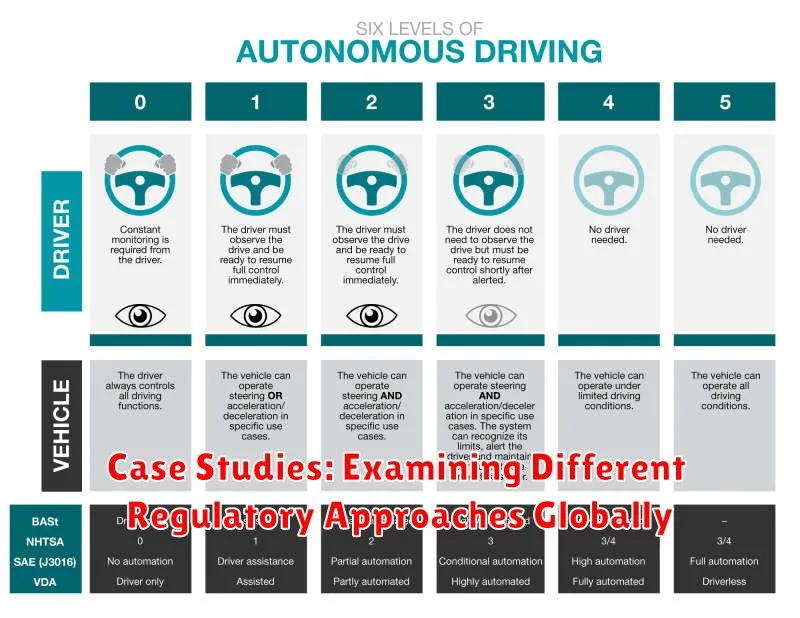
The global landscape of self-driving car regulations is diverse and evolving. While many countries are actively developing frameworks, the approaches vary significantly, highlighting the complexities of navigating this nascent technology. Here, we explore some key case studies illustrating these diverse approaches.
United States: The US adopts a largely state-by-state approach, with California being a pioneer in setting stringent testing and licensing requirements. This fragmented approach creates challenges for manufacturers, as they must adapt to multiple regulations. However, it also allows for experimentation and innovation, fostering the development of diverse self-driving solutions.
European Union: The EU takes a more centralized approach, aiming for harmonized regulations across member states. The General Data Protection Regulation (GDPR) is a key piece of legislation shaping data privacy for self-driving cars, emphasizing consent and data security. This approach aims to ensure consistency and consumer protection, but it can also create complexities for manufacturers operating in multiple EU markets.
China: China, a major player in the autonomous vehicle industry, is rapidly developing regulations, adopting a mix of strict and supportive measures. The government encourages innovation and prioritizes domestic manufacturers, while implementing safety and cybersecurity regulations. This approach reflects China’s ambition to be a leader in autonomous vehicle technology.
Japan: Japan focuses on practical applications and public acceptance, prioritizing smooth integration of self-driving vehicles into its existing infrastructure. The government is actively exploring public-private partnerships and promoting safety through robust testing and public awareness campaigns. This pragmatic approach emphasizes user-centricity and a gradual transition towards autonomous mobility.
These diverse approaches underscore the need for global collaboration in developing best practices for regulating self-driving cars. Open communication and information sharing are crucial to fostering innovation while ensuring safety and public trust.
